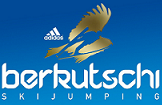Recent news:
7000th ski jumping hill added to the Archive!
New Granåsen ski jump in Trondheim inaugurated
Fire destroys ski jumps in Biberau-Biberschlag
Copper Peak: Funding of the renovation finally secured
200 ski jumping facilities in the USA
Send us your ski jumping hill photos and information via email!
Latest updates:
2024-04-24
2024-04-23
Advertisement:
Partner:




 Molde
Molde
Moldeheia
Data | History | Hill records | Map | Comments
.
Moldeheibakken:
| K-Point: | 60 m |
  Hill record: Hill record: |
66.0 m (Bjørn Wirkola  , 1962, N-NOR) , 1962, N-NOR) |
History:
The first initiatives to build a ski jump in Moldeheia happened in 1922. The plans and preparations for it started the year after. The hill, whose location was near the club house of Molde og Omegn IF (MOI), saw its first test jumps in February 1924, where distances between 30 and 38 meters were reached. And so it was chosen as the venue for a regional championships in March. But this event was surely not a success. The profile of the landing slope was too much of a downhill skiing slope, the inrun was sluggish and the inrun radius just too sharp.
In autum 1924, MOI and landowner Ulrich Møller both agreed a contract, which gave MOI the license to use the area for the next 50 years. In 1925, the profile was improved, the year after a judges' tower was built. Local media reported jumps between 38 and 50 meters, however hill records were not documented. In 1926 and 1927, Romsdal Championships took place, before the National Championships should follow in 1927. Unfortunately, these had to be canceled due to a lack of snow. Eventually, the event was held the year after.
In 1930, the participant field of the regional championships was extended with participants from Møre, Gudbrandsdalen, Sør-Trøndelag and Trondheim and also with Knut Kobberstad from Oslo district Lyn and the new-crowned World Champion Gunnar Andersen from Modum. These two crashed during the competition, because the snow in the inrun was too loose. So, they decided to do one more jump after the competition, where Andersen reached 51.5 and Kobberstad 52 meters. A junior jumper, Ragnvald Sele, even reached 54 meters, but could not land it.
The following winter was snow-poor and so MOI had to wait until April to finally organize a competition. There, Silver Medallist of the Olympic Championships in Lake Placid, Hans Arnold Beck, jumped a new official hill record of 51.5 meters. In a show-jump he even jumped 54 meters.
For 1934, MOI applied as a host for the Norwegian National Championships, but the federation preferred Porsgrunn. One year later, the application was successful, which led into a conversion of the Moldeheibakken. The hill profile was adapted once again and grandstands were built. The competitions were held from March 7th till 10th and the weather was just perfect. About 12,000 spectators enjoyed watching the best Nordic athletes from the whole country. This number of spectators is worth mentioning since Molde itself only had 3,500 inhabitants. Arne B. Christiansen became new ski jumping champion, while Olav Lian took the victory in Nordic Combined. Also thanks to a new hill record of 55.5 meters.
Even before World War II, MOI aimed to build an additional training facility. But the war delayed the activities and so the hills in Mølleråsen could not be opened before 1947. Afar from that, Moldeheibakken lost its importance and so there were even thoughts of building a completely new large hill.
But, after Molde was awarded as a host of some disciplines of the Norwegian Championships in 1962, Moldeheibakken once again was modernized in the early 1960's. The inrun was moved up a few meters, which enabled longer jumps, such as the final hill record of no other than Bjørn Wirkola. Back then as a junior jumper, he reached 66 meters during competition, after he even beat the 70 meters during training. It was supposed to be the last highlight in the history of Moldeheibakken.
In 1965, MOI thought about building a new large hill on Nonnsmyra, but that never happened. However, the municipalities of Molde, Fræna and Eide came together to discuss plans for a new ski jump. Eventually, it was built and inaugurated in March 1969 and today is known as Skarbakken.
 Hill records K60 (Men):
Hill records K60 (Men):
 Map:
Map:
Advertisement:




 Herschdorf
Herschdorf Akureyri
Akureyri  Vuokatti
Vuokatti Dolná Lehota
Dolná Lehota  Kumen
Kumen 










Post comment: